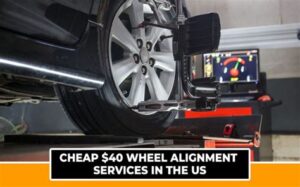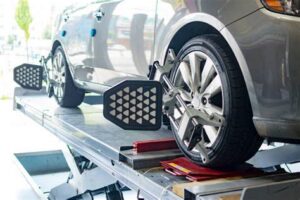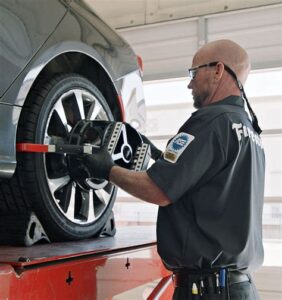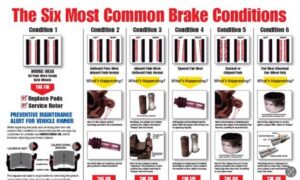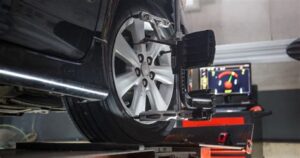Is your vehicle veering to the right after a recent alignment? This common issue can be both frustrating and potentially dangerous. Understanding the underlying causes of your car pulling post-alignment is essential for not only your safety but also for maintaining the longevity of your vehicle. Factors like improper tire pressure, misalignment symptoms, and more can contribute to this problem. In this article, we’ll explore common causes of car pulls after alignment, how to identify signs of misalignment, and what steps you can take to rectify these issues. Whether you’re a seasoned car enthusiast or a casual driver, our professional solutions will guide you toward a smoother, safer ride. Let’s dive in and get your car back on the straight and narrow.
Common Causes Of Car Pulls After Alignment
Experiencing that your car pulls to one side, particularly after an alignment, can be both frustrating and concerning. Understanding the common causes behind this issue can help you identify and rectify the problem effectively. Here are some of the prevalent reasons:
| Cause | Description |
|---|---|
| Tire Issues | Worn or uneven tire tread can cause the vehicle to pull to one side. It’s essential to regularly inspect your tires for signs of wear and replace them as necessary. |
| Brake Problems | If one of your brakes is sticking or malfunctioning, it can create a drag on that wheel, causing your car to pull towards the affected side. |
| Suspension or Steering Components | Worn or damaged suspension parts or steering components can lead to incorrect alignment settings and may result in your car pulling after an alignment. |
| Road Conditions | Driving on uneven or sloped roads can give the illusion that your car is pulling. Always assess the road conditions before concluding that there is an alignment issue. |
| Improper Alignment Settings | In some cases, an alignment may not be performed correctly due to equipment failure or technician error, leading to a persistent pull. |
By keeping these potential causes in mind, you can take appropriate steps to diagnose and remedy the situation, ensuring a safer driving experience.
How Tire Pressure Affects Car Pulls
Tire pressure plays a crucial role in ensuring your vehicle drives straight and handles properly. When car pulls to the right or left, one common culprit can be improper tire pressure. Here’s how tire pressure impacts your vehicle’s performance:
- Under-inflated Tires: When tires are not sufficiently inflated, they can create excessive drag on one side of the car. This can lead to pulling, as the lower pressure causes uneven wear and handling characteristics.
- Over-inflated Tires: Conversely, over-inflated tires can reduce the contact area with the road, which may lead to a loss of traction. This imbalance can also result in your car pulling in one direction, especially if the pressure is uneven across the tires.
- Sidewall Wear: Maintaining proper tire pressure minimizes sidewall flexing. An imbalanced tire due to incorrect pressure can cause wear on one side, leading to a noticeable pull.
To illustrate the impact of tire pressure on car pulling, consider the following table:
| Tire Condition | Effect on Steering |
|---|---|
| Under-inflated | Pulls to the side of the lower pressure tire |
| Over-inflated | Pulls to the side of the higher pressure tire |
| Properly inflated | Drives straight and balanced |
Regularly checking and maintaining your tire pressure is critical for optimal handling and to prevent your car pulls issue from becoming more troublesome. Always refer to your vehicle’s manual for the recommended tire pressure and inspect them routinely for any signs of wear or unevenness.
Identifying Signs Of Misalignment In Your Car
Recognizing the signs of misalignment early can save you from more extensive damage and ensure a safe driving experience. Here are some common indicators:
- Car pulls to one side: This is the most obvious sign, where your vehicle drifts to the right or left even when you’re not steering.
- Uneven tire wear: Check your tires for wear patterns. If the inner or outer edges seem worn down, it could indicate misalignment.
- Steering wheel off-center: When driving straight, your steering wheel should be centered. If it’s tilted to one side, this may point to alignment issues.
- Vibration or shaking: You might notice a vibration in the steering wheel when the car is in motion, which could also signal alignment problems.
- Reduced handling performance: If your vehicle feels less responsive to steering inputs, it could be a symptom of misalignment affecting your vehicle’s stability.
If you experience any of these symptoms, it’s advisable to have your vehicle inspected. Catching misalignment issues early can help maintain the overall health of your car and ensure a smoother ride.
Steps To Take When Your Car Pulls To The Right
If you notice that your car pulls to the right after an alignment, it can be frustrating and potentially dangerous. Here are the steps you should take to address this issue:
Taking these steps can help you pinpoint the cause of your car pulls issue and determine whether professional assistance is needed to resolve the problem effectively.
Professional Solutions For Persistent Car Pull Issues
If your car pulls to the right even after an alignment, it can be both frustrating and concerning. Dealing with persistent pulling requires a systematic approach to ensure that all potential issues are addressed. Here are some professional solutions to consider:
1. Comprehensive Wheel Alignment Check: Sometimes, the initial alignment may not have been performed accurately. Visiting a certified technician for a detailed wheel alignment check can uncover any overlooked misalignments.
2. Suspension System Inspection: A thorough inspection of the suspension components is essential. Worn-out parts, such as control arms, bushings, or shocks, can contribute to uneven weight distribution, leading your strong>car pulls to one side.
3. Brake System Examination: Uneven braking caused by sticking calipers or imbalanced brake pads can also cause your car to pull. A professional brake inspection can ensure everything is functioning properly.
4. Tire Replacement or Rotation: If your tires are unevenly worn or damaged, it might make your car pull to the right. Replacing or rotating the tires in accordance with manufacturer specifications may solve the issue.
5. Wheel Balancing: An unbalanced wheel can impact how your car handles. Ensuring that all four wheels are properly balanced can enhance stability and reduce pulling.
6. Steering System Assessment: An improperly functioning steering system can lead to erratic behavior in your car. Consulting a professional for a steering system assessment can pinpoint any issues and lead to resolution.
7. Regular Maintenance: Consistent inspections and maintenance of key vehicle components will help prevent future problems. Regular check-ups can aid in detecting misalignments before they escalate.
By taking these professional solutions into account, you can effectively address the problem of your car pulls to the right, ensuring a safer and smoother driving experience. If the issue persists, it may be worth consulting with multiple technicians for a second opinion.
Frequently Asked Questions
What are common reasons a car pulls to the right after an alignment?
Common reasons include improper alignment settings, uneven tire pressure, and tire wear or damage that may not have been addressed during the alignment.
How can I check if my tire pressure is causing the pull?
You can check your tire pressure using a tire pressure gauge. Ensure all tires are inflated to the manufacturer’s recommended pressure, as differences can cause the vehicle to pull.
What steps can I take if my car still pulls to the right after an alignment?
If your car continues to pull to the right, consider re-visiting the mechanic for a check-up, inspecting the tires for uneven wear, or having the suspension components examined.
Could undeclared damage to my suspension cause my car to pull to the right?
Yes, damaged or worn suspension components can affect wheel alignment and lead to pulling. It’s advisable to have the suspension inspected if there’s a persistent pull.
Is it possible for the road surface to influence my car pulling to the right?
Absolutely, road conditions such as slopes, crowned roads, or uneven pavements can contribute to a vehicle pulling to one side. Testing on different surfaces can help diagnose this.
Should I rotate my tires if my vehicle is pulling to the right?
Yes, rotating your tires can help even out wear and improve handling. However, ensure that any tire issues are addressed before rotation.
When should I seek professional help for my car pulling to the right?
If the pulling persists after alignment adjustments and simple checks like tire pressure, it’s advisable to consult a professional mechanic for a thorough inspection.
